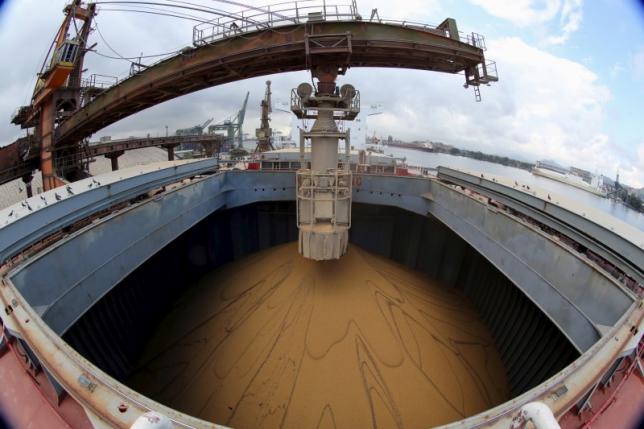A Chinese ship is loaded with soybeans at Port of Santos May 19, 2015. REUTERS/Paulo Whitaker
 (Reuters)Brazil does not appear to have over-shipped its soybeans to the extent that it did for corn this season, and there is evidence that the country’s yearly soybean export target may need to be reduced.
(Reuters)Brazil does not appear to have over-shipped its soybeans to the extent that it did for corn this season, and there is evidence that the country’s yearly soybean export target may need to be reduced.
A potential tightening in global soybean supply has caused concern in agriculture markets lately. The ongoing wrapup of South America’s 2015-16 soybean season will set the tone for the new marketing year with particular focus on Brazil, the world’s leading soybean supplier.
Brazil’s June soybean shipments fell sharply from both the previous month and previous year by at least 20 percent. Both the recent decline in exports and current port lineup data for July suggest that the country may not experience a sudden domestic soybean shortage similar to the one that surfaced earlier this year for corn.
This should come as a relief to domestic consumers, but the Brazilian government is not taking chances. Late last month, the agriculture minister announced that bean import limits from China and Mexico would be lifted to curb this year’s production shortage.
But just because Brazil may be left with a few more soybeans sitting around than it had expected, it does not necessarily mean that the world will too.
CORN REPEAT UNLIKELY?
Brazil typically ships the majority of its corn between September and February. When this year’s campaign finally wound down into April, the country had shipped an additional 15 million tonnes of corn over the previous season.
This borderline reckless surge in exports was despite the Brazilian corn crop being forecast below the volume of the prior year from the start. Domestic buyers, particularly livestock farmers, found themselves scrambling for the scarce and pricey grain, and the country was forced to turn largely to its neighbors, Argentina and Paraguay, to ease the shortage.
As soon as corn exports wind down, soybeans take center stage with peak shipment volumes occurring between April and June. After this April’s record soybean volume exceeding 10 million tonnes, Brazil seemed on track to create the same predicament for itself that it did with corn.
But that does not appear to be the case now after June shipments fell sharply. The current port lineup from Brazil’s Williams Shipping Agency does not have a great deal of activity on the docket for July, either.
Although the July port lineup is still preliminary, rough calculations imply that monthly soybean exports may be halved from June’s number and could also amount to half the volume that was shipped in July 2015. This is important because it slows the export pace such that seasonal shipment targets may be too high.
The U.S. Department of Agriculture, which forecasts demand worldwide, expects Brazil to ship 8 million more tonnes of soybeans in the current marketing year over the previous. USDA takes Brazil’s soybean marketing year to be October through September.
Between October 2015 and June 2016, Brazil exported exactly 10 million more tonnes of soybeans than the same period a year earlier. If July shipments fall as expected, this margin could be reduced to just 5 million tonnes by month’s end, putting USDA’s current estimate 3 million tonnes in excess.
If the slower export pace is carried through the final two months of the 2015-16 marketing year, USDA could be forced to lower its estimate for Brazil soybean exports anywhere from 2 million to 6 million tonnes.
MARKET IMPLICATIONS
Domestically, Brazil may need to add a few more soybeans to the balance sheet after the last shipment sails. But the global carryout might not be affected as Brazil’s lost business has likely come to the United States.
The slower June pace for Brazil soybeans was probably spurred by their increasing premium to the U.S. product. The Paranagua-U.S. Gulf spread peaked at $37 per tonne last month, the largest since late 2014.
This disparity was certainly reflected in U.S. soybean sales. In the month of June, total sales quintupled June sales of the previous two years. Old-crop sales were on average 2 million tonnes larger than what has been typical of June in recent years.
The current premium buyers will pay at Paranagua over the Gulf sits at $22, and unless buyers are specifically targeting the higher Brazilian quality, demand will probably continue to favor the United States.
This may not be the worst situation for Brazil, though, because this means that domestic soybean prices are much less likely to explode at the tail end of the export season, which is what happened with corn. A quick check of various Brazilian elevators reveals that soybean cash prices have steadily retreated since peaking about one month ago.
But on the global scale, the market will have to wait for confirmation of the increased U.S. soybean demand to ensure that global carryout should remain unchanged. Actual U.S. soybean shipments have been falling short of what the sales imply, so the export inspection data will tell the tale.
(Reporting by Karen Braun in Chicago; Editing by Matthew Lewis)
© 2016 Thomson Reuters. All rights reserved.

 Join The Club
Join The Club











